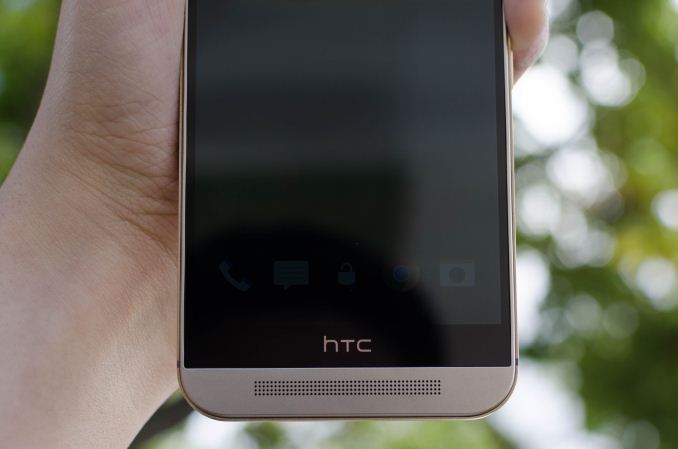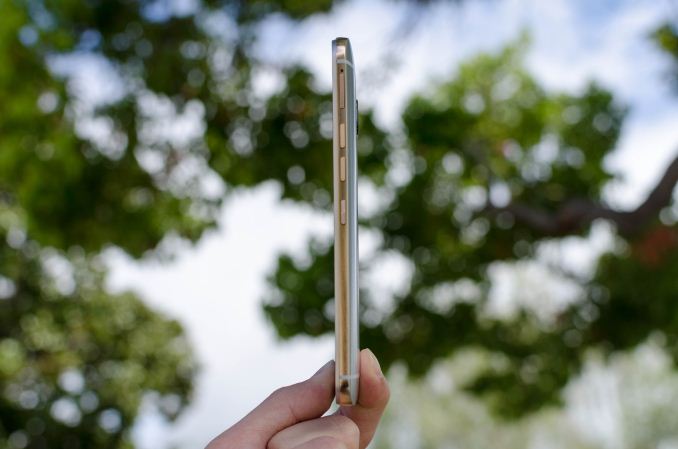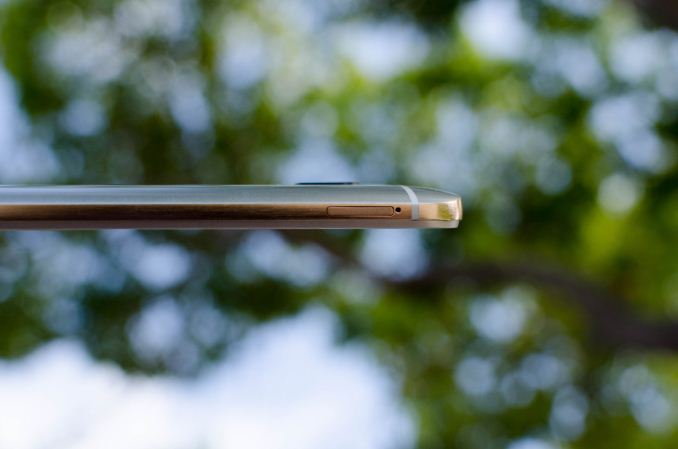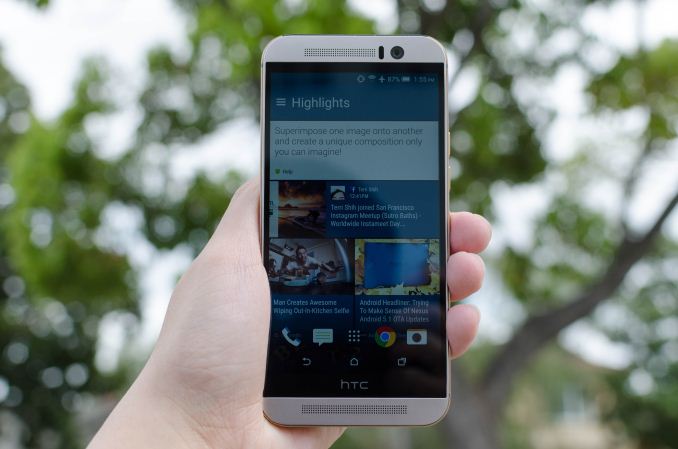The HTC One M9 Review: Part 2
by Joshua Ho on April 6, 2015 10:00 AM EST- Posted in
- Smartphones
- HTC
- Qualcomm
- Mobile
- Snapdragon 810
- One M9
Final Words
Now that we finally have all of the pieces together, we can come to some proper conclusions about the HTC One M9. For those that haven’t read part one of this review, it’s really necessary to do so to understand the context in which these comments are made.
There’s a lot to talk about here, so we’ll start with the design of the phone. HTC is probably the company best-known for design in the Android space, and with the One M9 it seems that they hope to capitalize on this by electing not to significantly change the design.
However, there are a few key changes to the One M9’s design when comparing it to the One M8. For instance, the One M9 moves the power button to the right side of the phone, changes the finish of the back cover, squares off the back cover, and replaces the front plastic bezel with a new plastic bezel. All of these changes seem to make some sort of sense at first, but they almost feel like a regression in some ways. The power button is on the side, but it takes a lot of effort to press it when the phone is held normally in the hand. However, it’s conveniently placed to accidentally press when picking the phone up from a table.
Meanwhile the back cover has a new finish and a neat dual-anodized color, but I question the value of these changes when they reduce yield and drive cost up, especially when sand-blasted anodized aluminum is comparable in look and feel. The continued use of the plastic bezel on the front also cheapens the feel of the phone. The new hard edges on the back cover is also quite uncomfortable, especially when compared to the M8’s smoother curve. There is also the issue of the “logo bar” bezel, but it’s physically impossible to get rid of this bezel due to engineering constraints.
The next aspect worth examining is the display. To HTC’s credit, a 1080p display at 5 inches is the right tradeoff to make with an RGB-stripe display. However, it’s concerning to see significant regressions in almost every area when comparing the display to the M8. An amazing display is almost a requirement for flagship smartphones at this point, and to see such a poor display with equally poor calibration is disappointing. It was clear in the past that HTC genuinely cared about delivering an amazing display, but somewhere along the way it seems that they forgot. We can speculate about the reasons behind this, but this is something that HTC has to fix if they want to remain relevant in the smartphone space, just like every other OEM at this point.
The other critical point of a smartphone is its ability to remain mobile. Battery life is probably the most important aspect of any smartphone, and a poor showing here can be enough to write off a phone. HTC has traditionally done quite well here despite using a smaller battery in their phones than average. Unfortunately, this isn’t true of the One M9. Despite using a newer SoC and a bigger battery, HTC regresses significantly in battery life when compared to the One M8. Although it seems that MIPI command mode has been removed from the One M9, it’s likely that most of the increased power draw can be directly attributed to the SoC, as the impact of panel self-refresh is relatively small.
Speaking of the SoC, the Snapdragon 810’s performance does generally provide a decent improvement over the Snapdragon 805, but it’s relatively little due to HTC’s governor settings which make it quite difficult to reach the maximum 2 GHz state. GPU performance is better than what we see on the Galaxy S6, but this is due to HTC’s choice to stay at a lower native resolution. At the same resolution, the Exynos 7420’s Mali T760 GPU is faster due to higher clock speeds. It’s also disappointing that HTC continues to use benchmark optimizations. The difference in performance is so small at this point that HTC should seriously consider removing these optimizations altogether, as it isn’t worth getting delisted from multiple benchmarks.
The camera of the One M9 is also a weak point, despite significant changes on HTC’s part in this area. Unfortunately, the post-processing here is just not acceptable, and the results of the camera are equally unacceptable. We will have to see how the camera performs without HTC’s heavy-handed post-processing when they update the camera to shoot in RAW, but HTC needs to improve dramatically here for next year.
The one positive note here is Sense 7, which continues to be one of the best experiences in Android overall. I fundamentally disagree with the assertion that a user should go to the Play Store to find various applications that they like, as taking this to its logical conclusion basically ends with having to download a dialer application from the Play Store on first boot. Blinkfeed continues to be a solid application for news, social media, and other information, and HTC’s apps in general are a strong point of differentiation judging by the demand from users to port them to non-HTC phones. However, I still think that HTC didn’t do enough for this iteration of Sense. Most of the applications still feel like they mesh best with Android 4.4, and overall the UI needs to be redesigned to fit with Material Design.
Overall, further testing of the One M9 basically confirms my fears, which were that the One M9 is effectively a sidegrade of the One M8 at best. I really did want to like this phone, as I still find the One M7 to be a great phone to use. I really wanted to see a phone from HTC that was worthy of an upgrade from the One M7, but the One M9 isn’t that phone. In fact, given that the One M8 is at least 200 dollars cheaper than the One M9 on contract, I find it incredibly difficult to recommend the One M9. It will definitely have its fans, but overall there are more negatives than positives. Given the competitive positioning of the One M9, the timing of the Snapdragon 810, and the strength of the Galaxy S6 I’m faced with an intense sense of déjà vu. It almost feels like we’re back where we started 3 years ago with the Sensation and Galaxy S2. I can't think of a better way to describe the situation HTC is in, which is alarming to say the least. The One M9 can't be another Sensation, but it feels like it is.














127 Comments
View All Comments
phoenix_rizzen - Wednesday, April 8, 2015 - link
Once you start using double-tap-to-wake, and double-tap-status-bar-to-sleep (some launchers even let you set double-tap-on-home-to-sleep), you'll find yourself rarely using the power button for anything.However, if you use your phone a lot for music, you'll really come to love having the power button and volume controls on the back of the phone. You don't have to put your hand in your pocket with the phone to manage the media. Just slide the phone into your pocket with the screen along your leg ... and the buttons are now accessible through the outside of the pocket! So much nicer that way. Especially with the headphone jack on the bottom, which makes the buttons align correctly when the phone is in your pocket (move your finger "up" or straighten it for volume up).
The other really nice thing about the G2 is that it has a 5.2" screen size ... but the overall phone size is smaller than most phones with only 5.0" screens. They're really done a great job keeping the overall phone sizes down since the Optimus G. I have no issues keeping my G2 in my front jeans pockets, front shorts pockets, or the inside pocket of my jackets.
Compared to the last 3 HTC and Sony phones, the LG G2 can be considered a compact phone.
melgross - Monday, April 6, 2015 - link
I think a big part of the problem is that Apple surprised the industry with the A7 64 bit SoC. Everyone is trying to catch up. But it seems likely that no one was actively working on 64 bits except Apple. The new Tegra looks good, but has its own problems with thottling, etc.Qualcomm was caught with its pants down. That's for sure. The 810 seems rushed, and is far from optimized. Perhaps later in the year, new tapeouts will fix some of the problems. Samsung's SoC is a bit better, but is still behind
aenews - Tuesday, April 7, 2015 - link
Well final versions of products haven't been released for the X1. And take in mind that even though the K1 was released earlier than the Snapdragon 805, even the Snapdragon 810 doesn't come close to matching it. And the X1 is "twice" as fast potentially. Even if the final performance is reduced in mobile settings, it would still be far, far faster than anything else =). And the K1 has no issue with throttling. Nvidia wouldn't let default settings be too aggressive if it meant throttling. The Snapdragon 810 would probably perform more admirably in these new devices with the temperature throttling turned off or adjusted in terms of temperature or reduced clock speeds.sonicmerlin - Saturday, April 11, 2015 - link
I would prefer a 32 bit A8X with my iPad Air 2 so I could have the increased RAM footprint of 64 bit apps back. Qualcomm was taken surprise by the public hype of 64 bit. Even the Nexus 9 suffers a bit with 64 bit and only 2 GB of RAM.JeffFlanagan - Monday, April 6, 2015 - link
HTC has made trading my M8 in for a Samsung Galaxy S6 an easy choice. I was probably already going to do it for the VR, but it's clear that their's no benefit to sticking with HTC.melgross - Monday, April 6, 2015 - link
Well, the consensus right now is that the S6 is the best Android phone for sure, but that the Edge is gimmicky and overpriced.jabber - Monday, April 6, 2015 - link
Amazes me that in this day and age a premium smartphone can still screw up the camera. How hard can it be? Forget gimmicks just get the basics right. With so many good off the shelf options...just bizarre.J4ckb1ng - Monday, April 6, 2015 - link
But the camera is a gimmick. A phone is designed to make and receive calls. How odd nobody seems to want a phone to do the one thing it is primarily designed to do. When I read HTC was fiddling with the camera on the M9, I heaved a sigh of relief.jabber - Monday, April 6, 2015 - link
If you said that 5+ years ago I would have tended to agree but that's no longer the case. The camera for many has become more important than making calls.I bet if you asked a survey of 1000 smartphone users what was the top three reasons for having a smartphone I'd be surprised if making calls scraped in at 3.
Refuge - Monday, April 6, 2015 - link
I saw that you are on your first smartphone in another post of yours. So I understand if you haven't converted yet.But Smartphones aren't phones. I mean they are, but they aren't.
They are hubs to the world. This is a communication device, that is meant to be mobile and contain every form of communication we could ever crave.
Instagram, facebook, youtube, text messaging, instant messaging, skype, Uvuu, phone too.
I use mine mostly for internet, email, and text. But thats just the nature of my business. Phone calls come through too, but only for things that can't be said one off in a text.